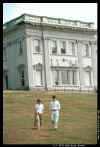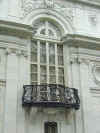|
newport mansions
|
||||
 |
 |
 |
 |
 |
| 001- John Banister Mansion | 002- Beacon Rock | 003- Beechwood | 004- The Breakers | 005- Chateau sur Mer |
 |
 |
 |
 |
 |
| 006- Chepstow | 007- The Elms | 008- Green Animals | 009- Hunter House | 010- Isaac Bell House |
 |
 |
 |
 |
 |
| 011- Kingscote | 012- Marble House | 013- Rosecliff | 014- Rough Point | 015- Miscellania |
| Crossing
Newport Bridge under the towering arches and soaring cable you get the
spacious sensation of visiting a cathedral. When the island city of Newport
comes into view from the height of the bridge a blindingly pure sunlight
doubles the religious effect. It was this sparkling clear sunlight that
inspired the Italian navigator Giovanni da Verrazzano to name Rhode Island
after the Greek Island of Rhodes when he first visited Narragansett Bay in
1524. The maritime city of Newport has inspired new arrivals through the course of a pre-Revolutionary War Golden Age, and through the 19th Century when the wealthiest families in America chose to build their summer mansions here. Newport is a gem in the New England coastline that offers early reflections of America’s nautical history, as well as preserved images of the Gilded Age of the 19th Century that were formed around the famous social circles of the Belmonts, Vanderbilts and the Astors. Local History: Newport has the stark, New England feel of Boston combined with that trader-rich, aristocratic sensibility of places like Charleston. Wharves, beaches and rocky coasts extend in all directions and the streets crowd each summer with tourists and seasonal residents. Newport’s power to attract visitors is astounding. In a city of 30,000 residents, within a state of 1,000,000 people, Newport hosts 3,500,000 visitors per year, culminating in the JVC Newport Jazz Festival held every August. On the coast of tiny, ocean-gripped Rhode Island, Newport was founded in 1639 by a group of settlers seeking a separate existence from the Portsmouth settlement. Like Charleston and Boston, Newport was nourished by the sea trade. Newport thrived in the pre-Revolutionary War years, trading rum for slaves, and slaves for molasses, which was used to produce more rum. (Although in 1774 Rhode Island became the first state to outlaw slavery.) This entrepreneurial spirit fueled the Golden Age of Newport, which ended abruptly when the British occupied the city from 1776 until 1779. Newport rose slowly from the destruction of the Revolutionary War. During the mid-19th Century, early steamship routes were established between Newport and New York. Direct access to New York rekindled Newport’s earlier role as a summer retreat for the rich. After the Civil War many of America’s wealthiest families built lavish mansions in Newport. These structures were commissioned using the best architects and finest materials available. They survive as unique testaments to the post-Civil War American aristocracy. Relics of the Gilded Age: Newport is all about the indelible spirit of America, its nautical heritage, and its unique culture of wealth. The Colonial and Georgian architecture has a stringent, sentry-like appeal that is born of New England. Even the rows of European-styled mansions convey a chapter of robber baron Americana, with their fantastic opulence and their co-opting of varied stylistic flourishes. Bellevue Avenue is the legendary boulevard of the great mansions frequented by the American high society of the 19th Century, including the summer residence of the Astors. Ms. Caroline Schermerhorn Astor formed the list of 213 families whose ancestry could be traced at least three generations and this list became the original social register. For her Newport residence, Beechwood, Ms. Astor purchased the mansion of New York merchant Daniel Parrish. In 1881 Ms. Astor hired famed architect Richard Morris Hunt to undertake a $2 million renovation of Beechwood, which then became the social center of Newport’s Gilded Age. Another renowned “summer cottage” is The Breakers, the awesomely extravagant summer residence built by Cornelius Vanderbilt II. Completed in 1895 The Breakers was modeled by Richard Morris Hunt after a high renaissance Italian palace. There are 70 rooms crafted in rare marble and alabaster. For two years 2,500 workers labored on The Breakers to complete it at an estimated present day cost of $400 million. Despite the exclusive history of Newport high society, most of the great mansions are open for public tours. Similarly, most of Newport’s stunning coastline enjoys public access. Along the old wharves of Newport’s west coast is a popular thoroughfare, Thames Street, that offers shopping and a number of dockside restaurants. At the southeastern corner of Newport there is a three-mile coastal pedestrian path called the Cliff Walk that boasts unobstructed views of the rocky coast, as well as views of many of the great mansions. Along the southwestern coast of Newport is Ocean Drive, a ten-mile roadway leading to Brenton Point State Park. Brenton Point is one of the best locations in town to view the nightly event of a Newport sunset, sparkling in clear light and framed in rocky cliffs. Special thanks to
cloudtravel |